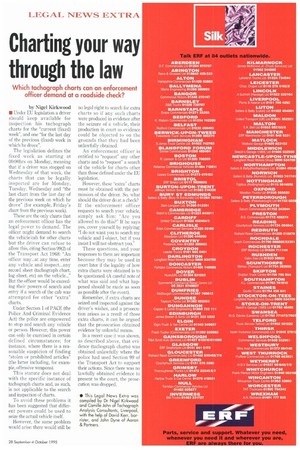Charting your way through the law
Page 25

If you've noticed an error in this article please click here to report it so we can fix it.
Which tachograph charts can an enforcement officer demand at a roadside check?
by Nigel Kirkwood • Under EU legislation a driver should keep available for inspection his tachograph charts for the "current (fixed) week", and one "for the last day of the previous (fixed) week in which he drove".
The legislation defines the fixed week as starting at 00:00hrs on Monday, meaning that if a driver was stopped on Wednesday of that week, the charts that can be legally inspected are for Monday, Tuesday. Wednesday and the last chart from the last day of the previous week on which he drove" (for example, Friday's chart from the previous week).
These are the only charts that an enforcement officer has the legal power to demand. The officer might demand to search the vehicle/cab for other charts but the driver can refuse to allow this, citing Section 99(2) of the Transport Act 1968: "An officer inay...at any time, enter any vehicle and inspect...any record sheet (tachograph chart, log sheet, etc) on the vehicle..." But the officer would be exceeding their powers of search and entry if a search of the cab was attempted for other "extra" charts.
Under Section 1 of PACE (the Police And Criminal Evidence Act) the police are empowered to stop and search any vehicle or person. However, this power can only be exercised in certain defined circumstances; for instance, where there is a reasonable suspicion of finding "stolen or prohibited articles" (the latter including, for example, offensive weapons).
This statute does not deal with the specific instance of tachograph charts and, as such, is not applicable to the search and inspection of charts.
To avoid these problems it has been suggested that different powers could be used to seize the actual vehicle itself.
However, the same problem would arise: there would still be no legal right to search for extra charts so if any such charts were produced in evidence after the seizure of a vehicle, their production in court as evidence could be objected to on the grounds that they had been unlawfully obtained.
An enforcement officer is entitled to "request" any other charts and to "request" a search of the vehicle for charts other than those defined under the EU However, these "extra" charts must be obtained with the permission of the driver. So, what should the driver do at a check? If the enforcement officer requests to search your vehicle, simply ask him: "Arc you allowed to do this?" If he says yes, cover yourself by replying: "I do not want you to search my vehicle and I object, but if you insist I will not obstruct you."
These questions, and your responses to them ate important because they may be used in court later if the legality of how extra charts were obtained is to be questioned. (A careful note of what was said and what happened should be made as soon as possible after the event).
Remember, if extra charts are seized and inspected against the driver's wishes, and a prosecution arises as a result of those extra charts, it can be argued that the prosecution obtained evidence by unlawful means.
In a recent case it was shown, as described above, that evidence (tachograph charts) was obtained unlawfully where the police had used Section 99 of the Transport Act to support their actions. Since there was no lawfully obtained evidence to present to the court, the prosecution was dropped.
• This Legal News Extra was compiled by Dr Nigel Kirkwood and Camille John of Tachograph Analysis Consultants, Liverpool, with the help of David Kerr, barrister, and John Dyne of Aaron & Partners.




































































































































